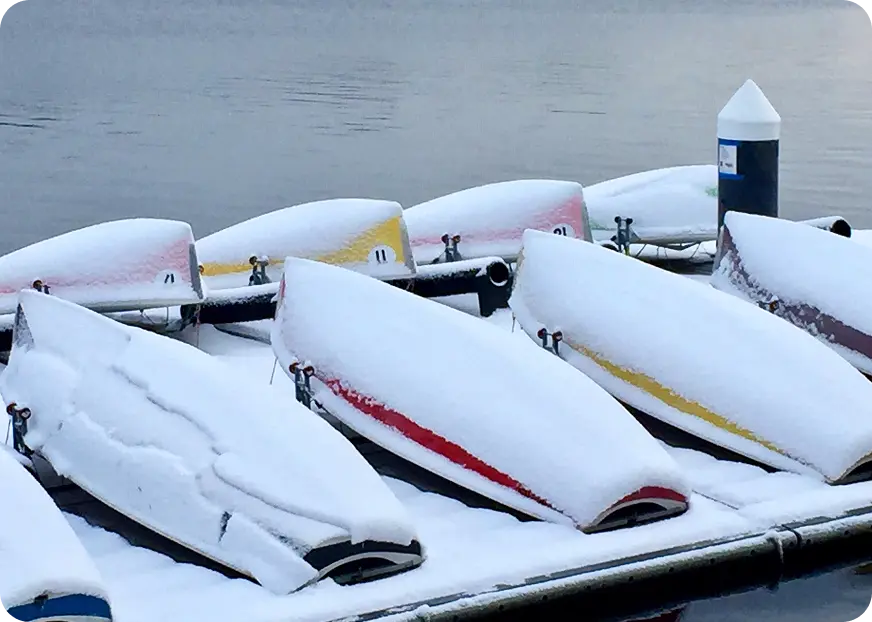As the boating season winds down, it’s time to start thinking about boat storage. If this is your first boat, then it’s important to make sure you understand all the necessary steps needed to avoid damage to it over the winter months. Storing your boat goes beyond finding a storage facility. You also need to protect it, so it is in top condition when the warm weather rolls around again. Here are 16 tips on storing your boat to keep it safe and sound this winter.
1. Choose your mode of storage
First, you have to decide where you’ll be storing your boat. If your property allows it, this is the most affordable option. You can simply park it in your driveway or garage until the spring. Just keep in mind that keeping it on the trailer can bear down on the wheels and cause damage over a prolonged amount of time. The next option is an outdoor storage facility. There are hundreds of choices available both near where you use your vessel as well as closer to home. The only issue with outdoor storage of any kind in Ottawa is that the winters tend to be quite harsh. So, you need to take extra care to prepare your boat. That leaves indoor facilities. If you can afford this option, it is by far the best choice to protect your boat not only from the elements, but also from vandals and thieves.
2. Take a final test run
Take your boat on the water for a short trip to look for signs of possible issues. If anything sounds off or the boat isn’t running properly, then have it looked at before putting it into storage.
3. Inspect the hull
Remove your boat from the water and do a thorough check of the hull. Cracks and damage to the hull will worsen over the winter if you don’t repair them now. If you have a fiberglass boat, then look for blistering and be sure to repair those spots as well.
4. Drain the fluids
Your boat has several types of fluids as well as areas that will carry liquid with them when lifted from the water. Everything has to be drained to avoid freezing issues that will cause serious damage, including:
- Bilge
- Water tanks
- Head
- Pipes and seacocks
You can try raising the bilge to help it drain faster. Also, you can’t drain the engine water tank until it is winterized.
5. Electric water heater
If your boat has an electric water heater, then you’ll have to remove the in and out lines and connect them together.
6. Apply lubricant and antifreeze
Once everything is drained, you need to use a moisture-displacing lubricant spray on the bilge. You also have to add antifreeze to the bilge and water tanks.
7. Clean it up
Use warm soapy water to scrub down the hall and interior of the entire boat. Pay close attention to things like plant life or barnacles, and remove them from the hull. Go through all your storage areas and appliances to make sure they are empty and clean. Vacuum out areas where food was stored to reduce risk for rodents finding a home. Then, allow the boat to dry out thoroughly.
8. Wax the boat
Once the boat is dry, apply a coat of wax to the superstructure and hull, and polish it evenly.
9. Winterize the engine
Flush the engine and coolant system with freshwater, and refill the coolant system with antifreeze. Warm the engine briefly so you can loosen up the oil, and then replace the oil and filters. Look to see if the oil looks milky, as this means you have water intrusion. Apply fogging oil into the carburetor as well as the spark plug holes, and remove the drive belts and store them separately. Fill the tank with a mix of gas and stabilizer.
10. Apply lubricant
The steering system and control mechanisms have to be greased, and you also have to apply a light coating of moisture-displacing lubricant on metal hinges, latches, and linkages. The propellor has to be lubricated by first detaching it, and checking it for fishing line and seal damage. You can then put it back in place.
11. Remove the battery
Remove the battery and charge it, then clean the terminals, and apply a light coating of grease. Also, coat the battery cable ends, and then store the battery separately in a warm, dry place until the spring.
12. Seal the exhaust ports
If you have exhaust ports, they have to be sealed with duct tape to keep pests out.
13. Take everything off the boat
Anything that is not part of the vessel should be stored separately such as fire extinguishers, flares, life jackets, cushions, and any food. Also, things like life jackets and pillows, including leather or fabric items, can get mouldy or coated in mildew if left on the boat. Your electronics are susceptible to the cold, so they should be taken home for the winter, or you can store them with your battery. If there are any exposed wires or cable ends, then wrap them with electric tape.
14. Cover your boat
A suitable boat cover is a must to help protect your boat against the winter weather. In Ottawa, it is a good idea to consider having your boat shrink-wrapped.
15. Visit often
To make sure your boat remains protected throughout the winter, try to visit every few weeks if you can. It is important to remove snow buildup regularly and look for damage to the boat’s components. Any damage you spot should be repaired right away. You should also remove pooled water.






